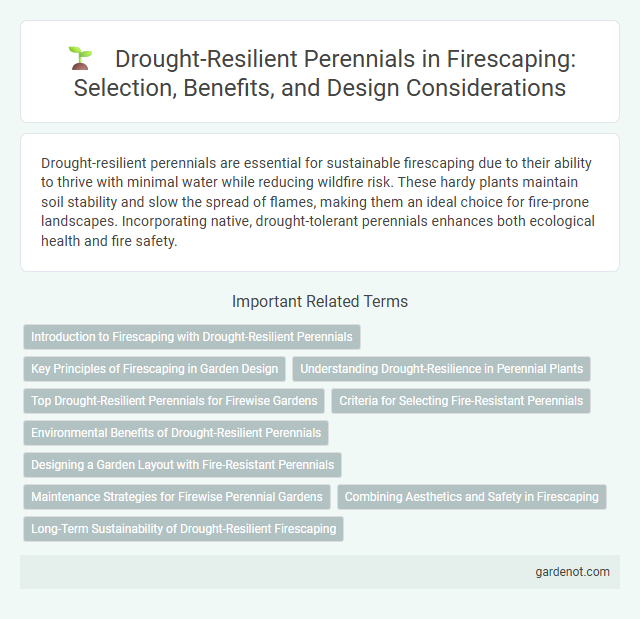Drought-resilient perennials are essential for sustainable firescaping due to their ability to thrive with minimal water while reducing wildfire risk. These hardy plants maintain soil stability and slow the spread of flames, making them an ideal choice for fire-prone landscapes. Incorporating native, drought-tolerant perennials enhances both ecological health and fire safety.
Introduction to Firescaping with Drought-Resilient Perennials
Drought-resilient perennials play a crucial role in firescaping by reducing water usage while enhancing landscape fire resistance. These plants, such as lavender, yarrow, and salvia, possess low flammability and deep root systems that improve soil stability during dry periods. Incorporating drought-tolerant perennials into fire-resistant landscaping strategies supports sustainable water management and minimizes wildfire risks.
Key Principles of Firescaping in Garden Design
Drought-resilient perennials play a critical role in firescaping by reducing water use while maintaining garden health and fire resistance. Selecting native or adapted species with low fuel volume and moisture retention helps create defensible spaces that hinder wildfire spread. Incorporating proper plant spacing and layering enhances airflow and minimizes continuous fuel, key principles in designing fire-safe gardens.
Understanding Drought-Resilience in Perennial Plants
Drought-resilient perennials possess deep root systems and adaptive physiological traits that enable efficient water use and retention during prolonged dry periods. Understanding drought-resilience in perennial plants involves studying their stomatal control, osmotic adjustment, and carbon allocation strategies that minimize water loss and enhance survival. Selecting species native to arid regions ensures optimal performance in firescaping landscapes while maintaining ecological balance and reducing irrigation needs.
Top Drought-Resilient Perennials for Firewise Gardens
Agave parryi and Echinacea purpurea rank among the top drought-resilient perennials ideal for firewise gardens due to their low water needs and high heat tolerance. These species retain moisture efficiently and possess thick, fibrous foliage that resists ignition, enhancing landscape fire safety. Incorporating Salvia leucophylla further improves drought resilience while supporting pollinators, creating a sustainable and fire-resistant garden ecosystem.
Criteria for Selecting Fire-Resistant Perennials
When selecting drought-resilient, fire-resistant perennials for firescaping, prioritize species with high moisture content in leaves and low volatile oils to minimize flammability. Opt for plants that have deep root systems to withstand prolonged dry periods and recover quickly post-fire. Perennials with a compact growth habit and minimal dead material accumulation reduce fuel load and enhance landscape safety during wildfires.
Environmental Benefits of Drought-Resilient Perennials
Drought-resilient perennials significantly reduce water consumption by thriving in arid conditions, promoting sustainable landscaping practices. Their deep root systems improve soil health and prevent erosion, enhancing ecosystem stability. These plants also provide habitat for pollinators, contributing to biodiversity conservation in drought-prone areas.
Designing a Garden Layout with Fire-Resistant Perennials
Incorporating drought-resilient perennials such as lavender, yarrow, and Russian sage into garden layouts enhances fire resistance by reducing flammable vegetation. Spatially arranging these fire-resistant perennials with adequate clearance around structures minimizes fire spread risk while maintaining aesthetic appeal. Choosing plants with high moisture content and low resin further supports the creation of defensible landscapes in fire-prone areas.
Maintenance Strategies for Firewise Perennial Gardens
Drought-resilient perennials such as Lavender, Salvia, and Yarrow thrive in Firewise gardens by reducing water needs and enhancing fire resistance through deep root systems and minimal foliage. Strategic maintenance includes regular pruning to remove dead material, mulching with non-flammable materials to retain soil moisture, and avoiding dense planting to minimize fuel loads. Monitoring soil moisture levels and implementing drip irrigation systems ensure perennials remain healthy while supporting fire risk reduction in arid climates.
Combining Aesthetics and Safety in Firescaping
Drought-resilient perennials such as lavender, yarrow, and Russian sage offer both aesthetic appeal and fire-resistant properties essential for effective firescaping. Their low water requirements and high moisture content help reduce fuel load, minimizing wildfire risk while maintaining garden beauty. Incorporating these plants strategically enhances landscape safety without sacrificing design elegance.
Long-Term Sustainability of Drought-Resilient Firescaping
Drought-resilient perennials such as lavender, yarrow, and sedum contribute significantly to the long-term sustainability of firescaping by reducing water consumption and enhancing soil stability. Their deep root systems help retain moisture and prevent erosion, creating fire-resistant landscape zones that endure extended dry periods. Incorporating these perennials supports ecosystem health while minimizing irrigation needs and wildfire risks.
Drought-resilient perennial Infographic

 gardenot.com
gardenot.com